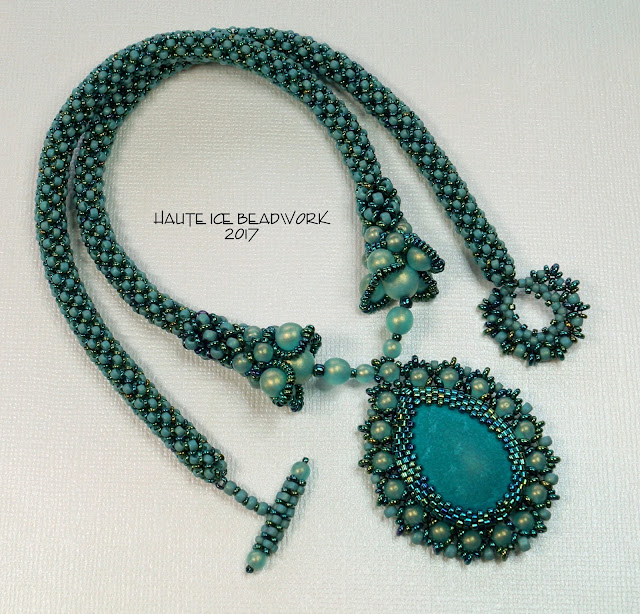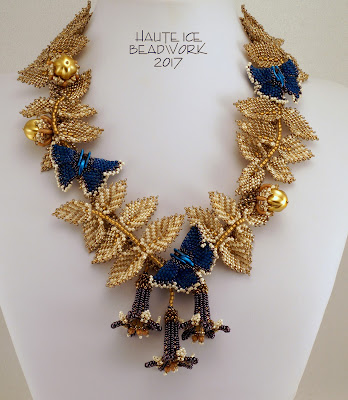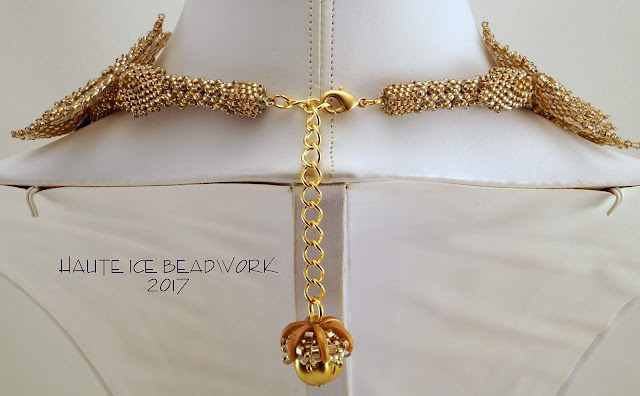Many of my tutorials call for the application of leather to the back of a Swarovski "Fancy Stone".
These stones have pointy backs with an anodized coating that reflects light back out of the glass to yummy effect. I cover the backs with leather for several reasons.
First, the backs can be nicked or chipped if dropped, or sometimes just through repeated use, the backing shows wear. Vintage stones are especially susceptible to damage, and the most recent ones are the sturdiest. So one purpose of my leather backing is protection.
The second purpose is aesthetic. I think the exposed silver backing does not merge nicely with the beadwork that is not silver itself. I use lots of color in my designs, so I want to have a matching backside for the work, like this one below.
I also think sometimes necklaces can be made reversible, affording a more casual result and turning a very sparkly stone into just a beautiful shape to work around, like in my Pineapple Blossom necklace.
Finally, I think there is a comfort factor. I like the feel of the soft leather against my skin, more than the cold, pointy anodized backing.
Lots of things are hard to learn from just hearing how they are done, but much easier to understand when seen. Honestly, I could not imagine how Peyote stitch was done, despite looking at a diagram, until I took my first beading class.
SO, here, to add to the text and photo instruction I have provided in my tutorials, is a little video for you. It's my first try, and my cameraman husband did not know I was planning to get the job done in one go, so he speaks up, which is added entertainment for you. I know, I know, I really must learn to edit and create lovely films, but I think the need here is immediate, so without further ado...
The jewel used in the demo is Iridescent Green, which means it has a factory coating on its surface. As you saw I was able to rub off a glue mistake with my thumb at the edge, and you will be able to do that on the surface as well, even with color coated finishes like AB, but this is safest with modern stones, Be very gentle with vintage finishes. Be sure to let the adhesive dry before you try to rub it off.
My rice bed is immense because I do a dozen jewels at a time. Yours can be much smaller. Something with a lid is a good idea, to avoid spills. I use an ancient margarine container, when I am gluing just one stone at a time. :)
My press cloth is light grey polyester organza. Protects my iron and the leather, keeps them from sticking to each other, and easy to see through to what you are doing. Any pastel or white works, but the grey is the most invisible.
I mention Poly Pellets, which are essentially Beanie Baby guts. I buy mine at the local craft store, but you can find them here, at Joann Fabrics. Rice beds are traditional in complex gluing projects. I learned the trick from my model-making son.
And these are the trimming scissors I adore from Gingher.
The pen is a roller ball, which works really well on leather and suede.
The adhesive I use here is E-6000, and a pointy applicator tip is not your friend for this project. A tube with a flat opening allows you to wipe on the adhesive thinly and evenly and the little ones are easiest to manipulate. Please be careful with this glue. The fumes (as the adhesive cures) are carcinogenic, which is why I recommend that you cure it for at least 6 hours, (and 24 is better) in a closed bathroom with the exhaust fan turned on. I just read about a new, reduced smell, non-carcinogenic adhesive from the same manufacturer, and I will test it in the coming weeks and report back here on it's usefulness for this purpose. NOTE! I have done all my more recent backing with Gem Tac from Beacon. It avoids the chemical connection entirely as it is a water-based adhesive. It has been working great for me, and no clients have complained.
Please forgive the primitive nature of this video. I think, you have to start where you are, and I have already learned a great deal in creating this very simple little bit of film. Hang in there with me, and my efforts will improve with time.
Now go make yourself some pretty, leather backed Swarovski Fancy Stones!
These stones have pointy backs with an anodized coating that reflects light back out of the glass to yummy effect. I cover the backs with leather for several reasons.
First, the backs can be nicked or chipped if dropped, or sometimes just through repeated use, the backing shows wear. Vintage stones are especially susceptible to damage, and the most recent ones are the sturdiest. So one purpose of my leather backing is protection.
The second purpose is aesthetic. I think the exposed silver backing does not merge nicely with the beadwork that is not silver itself. I use lots of color in my designs, so I want to have a matching backside for the work, like this one below.
I also think sometimes necklaces can be made reversible, affording a more casual result and turning a very sparkly stone into just a beautiful shape to work around, like in my Pineapple Blossom necklace.
Finally, I think there is a comfort factor. I like the feel of the soft leather against my skin, more than the cold, pointy anodized backing.
Lots of things are hard to learn from just hearing how they are done, but much easier to understand when seen. Honestly, I could not imagine how Peyote stitch was done, despite looking at a diagram, until I took my first beading class.
SO, here, to add to the text and photo instruction I have provided in my tutorials, is a little video for you. It's my first try, and my cameraman husband did not know I was planning to get the job done in one go, so he speaks up, which is added entertainment for you. I know, I know, I really must learn to edit and create lovely films, but I think the need here is immediate, so without further ado...
The jewel used in the demo is Iridescent Green, which means it has a factory coating on its surface. As you saw I was able to rub off a glue mistake with my thumb at the edge, and you will be able to do that on the surface as well, even with color coated finishes like AB, but this is safest with modern stones, Be very gentle with vintage finishes. Be sure to let the adhesive dry before you try to rub it off.
My rice bed is immense because I do a dozen jewels at a time. Yours can be much smaller. Something with a lid is a good idea, to avoid spills. I use an ancient margarine container, when I am gluing just one stone at a time. :)
My press cloth is light grey polyester organza. Protects my iron and the leather, keeps them from sticking to each other, and easy to see through to what you are doing. Any pastel or white works, but the grey is the most invisible.
I mention Poly Pellets, which are essentially Beanie Baby guts. I buy mine at the local craft store, but you can find them here, at Joann Fabrics. Rice beds are traditional in complex gluing projects. I learned the trick from my model-making son.
And these are the trimming scissors I adore from Gingher.
The pen is a roller ball, which works really well on leather and suede.
The adhesive I use here is E-6000, and a pointy applicator tip is not your friend for this project. A tube with a flat opening allows you to wipe on the adhesive thinly and evenly and the little ones are easiest to manipulate. Please be careful with this glue. The fumes (as the adhesive cures) are carcinogenic, which is why I recommend that you cure it for at least 6 hours, (and 24 is better) in a closed bathroom with the exhaust fan turned on. I just read about a new, reduced smell, non-carcinogenic adhesive from the same manufacturer, and I will test it in the coming weeks and report back here on it's usefulness for this purpose. NOTE! I have done all my more recent backing with Gem Tac from Beacon. It avoids the chemical connection entirely as it is a water-based adhesive. It has been working great for me, and no clients have complained.
Please forgive the primitive nature of this video. I think, you have to start where you are, and I have already learned a great deal in creating this very simple little bit of film. Hang in there with me, and my efforts will improve with time.
Now go make yourself some pretty, leather backed Swarovski Fancy Stones!
















